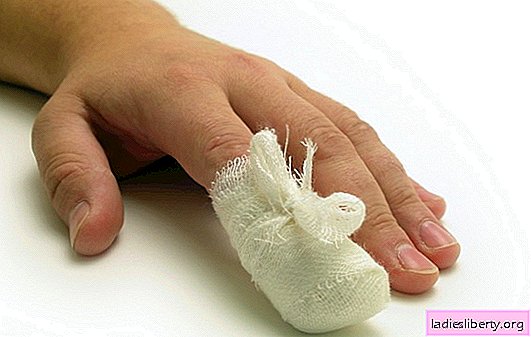
A bruise is a traumatic injury to a tissue or organ that is caused by one or another mechanical cause.
The most important difference between a bruise and other types of injuries is to maintain the physiological integrity of the damaged organ.
Bruises are most often domestic in nature and widespread.
Fortunately, for the most part, such damage is not dangerous to human health and life.
Nail bruise - mechanical damage to the nail plate and soft tissues of the terminal phalanx of the finger, not accompanied by a change in their physiological structure and integrity.
Despite the apparent rigidity, nails are prone to bruises no less. The nail plate itself refers to the horn formations. Nails do not have nerve endings and are not equipped with blood vessels (not vascularized), and therefore it is only possible to talk about a bruised nail.
The nail plate covers the soft tissue of the terminal phalanx of the finger. These tissues are rich in nerve endings and blood vessels. It is thanks to abundant vascularization and rich innervation that the fingertips (especially the fingers) are highly sensitive. The function of the nail is to protect the nerves and blood vessels, and it is the soft tissues located under the nail that are actually susceptible to injury.
However, the relatively small thickness of the nail, as well as the absence of a natural "barrier" between the plate and soft tissues (in the form of a muscle corset, etc.) leads to a low protective ability of the nail.
Fortunately, in spite of the frequency of this household injury, only isolated cases pose a real danger. But this is not easier: a nail bruise is accompanied by intense pain. Sometimes the intensity of the pain is so great that the finger (and in severe cases, the wrist or foot) practically lose their functions, and a person can not do everyday tasks.
To protect yourself from such an injury or to minimize discomfort from an already received bruise, you need to know the "enemy" in the face.
Nail bruise: causes
A bruise of the nail injury is so widespread that talk about the causes can only be summarized. According to medical statistics, the vast majority of visits to a medical center with a bruised nail were preceded by household chores and a finger punch on a hard surface or a heavy object falling onto a finger (about 90%). In the remaining 10% of cases, the causes of nail bruising were:
• Injury of fingers and toes (children are most susceptible).
• Walking or running.
Nail bruise: symptoms
Symptoms of a bruised finger are not specific enough, so it is necessary in any case to carry out differential diagnosis with a fracture of the finger, but only a doctor can cope with this. It is important for the patient to determine the presence of the following symptoms:
• Pain in the area of the damaged nail (on the arm or leg). The soft tissues that lie under the nail, as already mentioned, are rich in nerve endings, so the pain with bruising is almost always intense. Exceptions are minor damage, not accompanied by a symptomatic complex. The pains are dull, throbbing. In some cases, the pain can be so severe that it causes loss of consciousness.
• Violation of the motor activity of a damaged finger, hand or foot. In this case, a decrease in motor activity is not associated with organic changes in the hand or foot, but at the same time, a person cannot painlessly move his finger, move his hand or foot. Why? The pain radiates from the site of damage to the nerve endings. That is why discomfort can be felt remotely from the nail plate.
• Discomfort in the area of the nail plate. Discomfort with a bruised nail accompanies an injury from the moment it occurs. As a rule, patients complain of a feeling of heaviness or bursting under the nail. The reason for this is the development of a hematoma (volume accumulation of thickened blood) under the nail, which raises the plate.
• Swelling at the site of damage. Swelling at the site of injury is associated with fluid accumulation in the area of damaged tissue. In this case, edema can be significant.
• "Cyanosis" of the nail plate. The nail plate itself has a pale gray tint and a matte translucent texture. The color of the nail is determined by the intensity of blood supply to the soft tissues underneath. The blue or dirty gray color of the nail after a bruise is associated with the formation of a hematoma (or, more simply, a bruise). As a rule, the color of the nail does not change immediately, but after 8-12 hours from the moment of injury.
• Nail plate rejection. If the hematoma reaches a large size, the nail plate may “peel off”.
In addition to local symptoms in severe cases, general ones also develop:
• Headache.
• Raising the temperature to a level of 37-38 degrees.
• Nausea, weakness.
These signs indicate a severe inflammatory, and possibly concomitant, infectious process. If such signs are observed after a bruise, you should not postpone the visit to a specialist, it can be dangerous.
Nail bruise: diagnosis
From the point of view of diagnosis, a nail bruise does not present great difficulties: the reason is obvious, characteristic local symptoms are observed. However, cyanosis, swelling of the tissues, intense pain accompany not only bruises, but also fractures. Therefore, diagnosis should be carried out carefully.
Diagnostic measures include:
• History taking. The standard survey procedure, during which the doctor specifies when and under what conditions the injury was received, how severe the pain syndrome is and asks a number of other leading questions.
• Palpation of a damaged nail. When carrying out palpation, it is important to consider that the pain can be very severe.
• Radiography. It is carried out in two projections. The purpose of the study is to exclude a fracture of the phalanx of the finger.
It is also important to know which specialist to contact if a nail bruise has been received.
• Traumatologist - a specialist who should be consulted first.
• The surgeon.
Nail bruise: treatment
Bruising a nail can seriously complicate life: it’s impossible to wear familiar shoes, even walking can become unbearable flour. It is clear that treatment should begin as soon as possible. Treatment measures for injuries begin with first aid. At the same time, it is important to know how to provide first aid to yourself: there simply may not be time to visit a medical center, and injury will not wait.
Do not underestimate the importance of first aid and think that if you go to the doctor in a couple of days with a wave of a magic wand, you will get rid of all the symptoms. On the contrary, the severity of symptoms in the future, as well as its duration, will depend on how quickly measures are taken.
Ideally, first aid should be provided within the next 30-60 minutes from the moment of injury.
So how do you help yourself?
• First of all, it is necessary to act on the damaged area with a low temperature. Cold is an ideal ally in the fight against bruises in general. Almost always, a nail bruise is accompanied by bleeding from damaged vessels. Low temperature will contribute to stenosis (narrowing) of the walls of the destroyed blood vessels and stop bleeding. Thanks to this, the size of the hematoma will be minimal and, quite possibly, everything will cost a little bruise, which does not render much discomfort. For use, it is recommended to use crushed ice wrapped in gauze or other cloth. Ice is applied to the damaged area for 2-5 minutes. After this, the pain should recede, otherwise you should repeat the procedure again after 15 minutes (and act in this way every quarter hour for 60-120 minutes).
If there was no ice at hand, you can do it with improvised means: bottles with chilled drinks, frozen convenience foods, etc. can be a replacement.
• Next, it is necessary to exclude the entry of infection into the body. An alcohol solution of iodine should be used. A cotton pad or swab is wetted in iodine, after which the surface of the nail plate is treated with a solution. In order to avoid the development of swelling of the surrounding tissues, an iodine grid can be applied to their surface.
If the bruise is severe, there is a high probability of rejection of the nail plate. Many mistakenly impede this process, impose pressure bandages. Do not do this, since the bandage interferes with the normal resorption of the hematoma, the normal nutrition of tissues, and contributes to the development of edema.
It should also be noted that medical care should not be neglected, when a bruise is accompanied by a rapid increase in symptoms, even despite the first aid provided. In this case, it makes sense to contact the medical center or the surgeon at the place of residence. Until the blood thickens and coagulates, it can be squeezed out from under the nail. To do this, the specialist makes a puncture (puncture) in the nail plate. Despite the apparent danger and pain of the procedure, everything is not so scary. The procedure lasts a few minutes and is accompanied by minimal discomfort.
If first aid is provided in a timely manner, treatment is minimal and is reduced to eliminating residual pain. In other cases, anesthetizing ointments are used, as well as compositions that promote resorption of hematomas (more often - heparin ointments).
Thus, a nail bruise is a common injury, but it causes a lot of inconvenience: pain, nail rejection, problems with walking and other usual actions, these are just some of its constant companions.
Also, a bruise of the nail often leads to cosmetic defects (after a complete rejection of the nail plate, the new one may look unaesthetic). Therefore, the problem should not be left to chance. It is important to turn to a specialist in time and know how to help yourself: it is known that first aid plays a decisive role in this matter.











